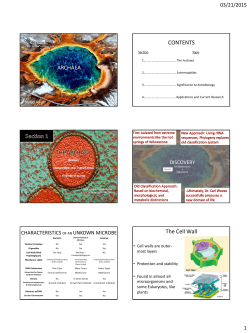
Lokiarchaeota: Biologists Discover `Missing Link` Microorganism
Home About Us News Archive Copyright HOME ASTRONOMY Privacy Policy Contact Us Newsletter RSS SPACE EXPLORATION ARCHAEOLOGY PALEONTOLOGY BIOLOGY PHYSICS Lokiarchaeota: Biologists Discover ‘Missing Link’ Microorganism May 7, 2015 by Sci-News.com Published in Biology Tagged as Archaea Bacteria « PREVIOUS A team of biologists, co-led by Dr Lionel Guy and Dr Thijs J. G. Ettema from Uppsala University in Sweden, has discovered a new group of microorganisms that represents an intermediate form in-between the simple cells of bacteria and the complex cell types of eukaryotes. Eukaryote Lokiarchaeota Follow Like 16k Share Tweet Like 12 58 41 You Might Like Bottlenose Dolphins Form Highly Complex Networks of Friends Rorqual Whales Have Unique Stretchy Nerves This false-color image shows a cell of thermophilic methanogenic archaea. Image credit: University of California Museum of Paleontology. In 1977, biochemist Dr Carl Woese and his colleagues at the University of Illinois described an entirely new group of organisms, the Archaea (originally found in extreme environments, such as hydrothermal vents and terrestrial hot springs). Extinction of World’s Largest Herbivores May Lead to Empty Landscapes, Say Researchers Sichuan Bush Warbler: New Bird Species Discovered in China New Study Shows How Bombardier Beetles Produce Defensive Spray Bats Have Unique Touch Sensors on Their Wings, New Study Finds The scientists were studying relationships among the prokaryotes using DNA sequences, and found that Archaea have distinct molecular characteristics separating them from bacteria as well as from eukaryotes. They proposed that life can be divided into three domains: Eukaryota, Eubacteria, and Archaebacteria. Despite that archaeal cells were simple and small like bacteria, scientists found that Archaea were more closely related to organisms with complex cell types, a group collectively known as ‘eukaryotes.’ This observation has puzzled biologists for years. Dr Guy, Dr Ettema and their colleagues from the University of Bergen, the University of Vienna, and Uppsala University, have described a new group of Archaea, named Lokiarchaeota, and identified it as a missing link in the origin of eukaryotes. The name Lokiarchaeota is derived from the hostile environment close to where it was found, Loki’s Castle, a hydrothermal vent system located on the Mid-Atlantic Ridge between Greenland and Norway at a depth of 2,352 meters. “The puzzle of the origin of the eukaryotic cell is extremely complicated, as many pieces are still missing. We hoped that Lokiarchaeota would reveal a few more pieces of the puzzle, but when we obtained the first results, we couldn’t believe our eyes. The data simply looked spectacular,” Dr Ettema explained. “Lokiarchaeota formed a well-supported group with the eukaryotes in our analyses,” Dr Guy added. The scientists found that Lokiarchaeota shares many genes with eukaryotes suggesting that cellular complexity emerged in an early stage in the evolution of eukaryotes. Two New Species of Iguanid Lizards Discovered in Chile “Our results provide strong support for hypotheses in which the eukaryotic host evolved from a bona fide archaeon, and demonstrate that many components that underpin eukaryote-specific features were already present in that ancestor,” the biologists said. “This provided the host with a rich genomic ‘starter-kit’ to support the increase in the cellular and genomic complexity that is characteristic of eukaryotes.” The details of the discovery are published in the journal Nature. _____ Anja Spang et al. Complex archaea that bridge the gap between prokaryotes and eukaryotes. Nature, published online May 06, 2015; doi: 10.1038/nature14447 The Choice Is Yours Elsevier's Top Soil Sciences Journals Offer Open Access Options
© Copyright 2025














